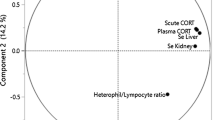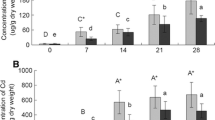Abstract
Combined lesser scaup (Aythya affinis) and greater scaup (A. marila) populations decreased from the 1980s to the 1990s and have not recovered. Factors limiting reproduction, including effects of contaminants and trace elements, have been highlighted as a concern in female scaup, but no studies have examined possible effects on male scaup. We examined the effects of cadmium, mercury, selenium, and corticosterone on pair status and on male reproductive indices, including testosterone, testes mass, and seminiferous tubule diameter, in male lesser scaup collected in the western boreal forest near Yellowknife, Northwest Territories, May and June, during 2004 and 2005. Male scaup that were larger in size (p = 0.048) and with better body condition (p = 0.038) were more likely to be paired. No relations were observed between independent variables and testosterone and testes mass. However, results suggested that seminiferous tubule diameter is influenced by a complex array of biologic and toxicologic parameters, which differ depending on pair status. Tubule diameters of paired male scaup were negatively influenced by hormones, whereas contaminants influenced diameter in unpaired male scaup. The effects of selenium were attenuated when bound with cadmium but not mercury. When selenium concentrations were high (greater than median value), there was a positive effect of cadmium on tubule diameter (R 2 = 0.30, n = 10, p = 0.007) but a negative relation with mercury (R 2 = 0.15, n = 10, p = 0.09). Seminiferous tubule diameter may be a sensitive indicator of sublethal effects of contaminants. This study showed contaminant and trace element effects at concentrations lower than threshold levels associated with major toxic effects. This study also demonstrated the complex nature of biologic systems and the importance of considering interactions to accurately characterize effects of metals.







Similar content being viewed by others
References
Afton A, Anderson M (2001) Declining scaup populations: A retrospective analysis of long-term population and harvest survey data. J Wildl Manage 65:781–796
Alabi NS, Whanger PD (1987) Influence of dietary selenium on metabolism of cadmium and mercury on reproductive tissues of rats. Ann Reprod Sci 13:143–155
Alabi NS, Whanger PD, Wu ASH (1985) Interactive effects of organic and inorganic selenium with cadmium and mercury on spermatozoal oxygen and motility in vitro. Biol Reprod 33:911–919
Alisauskas RT, Ankney CD (1994) Nutrition of breeding female Ruddy ducks: The role of nutrient reserves. Condor 96:878–897
Amann RP (1986) Detection of alterations in testicular and epididymal function in laboratory animals. Environ Health Perspect 70:149–158
Anderson BW, Warner DW (1969) A morphological analysis of a large sample of lesser scaup and ring-necked ducks. Bird Band 40:85–180
Anderson MG, Sayler RD, Afton AD (1980) A decoy trap for diving ducks. J Wildl Manage 44:217–219
Austin JE, Afton AD, Anderson MG, Clark RG, Custer CM, Lawrence JL, et al. (2000) Declining scaup populations: Issues, hypotheses, and research needs. Wildl Soc Bull 28:254–263
Austin JE, Custer CM, Afton AD (1998) Lesser scaup (Aythya affinis). In: Poole A, Gill F (eds) The birds of North America. The Birds of North America, Inc., Philadelphia, PA, p. 338
Berney PJ, Veniat A, Mazallon M (2003) Bioaccumulation of lead, cadmium, and lindane in zebra mussels (driessena polymorpha) and associated risk for bioconcentrations in tufted ducks (Aythia fuligula). Bull Environ Contam Toxicol 71:90–97
Birkhead TR, Buchanan KL, Devoogd TJ, Pellatt EJ, Szekely T, Catchpole CK (1997) Song, sperm quality and testes asymmetry in the sedge warbler. Ann Behav 53:965–971
Birkhead TR, Fletcher F, Pellatt EJ (1998) Testes asymmetry, condition and sexual selection in birds: An experimental test. Proc Royal Soc Lond B 265:1185–1189
Brown NL, Follett BK (1977) Effects of androgens on testes of intact and hypophysectomized Japanese quail. Gen Comp Endocrinol 33:267–277
Burrin DG, Ferrell CL, Britton RA, Bauer M (1990) Level of nutrition and visceral organ size and metabolic activity in sheep. Br J Nutr 64:439–448
Davis ES (2002) Male reproductive tactics in the Mallard, Anas platyrhynchos: Social and hormonal mechanisms. Behav Ecol Sociobiol 52:224–231
Denk AG, Kempenaers B (2006) Testosterone and testes size in mallards (Anas platyrhynchos). J Ornithol 147:436–440
Deviche P, Greiner EC, Manteca X (2001) Seasonal and age-related changes in blood parasite prevalence in dark-eyed juncos (Junco hyemalis, Aves, Passeriformes). J Exp Zool 289:456–466
Dloniak SM, Deviche P (2001) Effects of testosterone and photoperiodic condition in song production and vocal control region volumes in adult male dark-eyed juncos (Junco hyemalis). Horm Behav 39:95–105
Furness RW (1996) Cadmium in birds. In: Beyer WN, Heinz GH, Redmon-Norwood AW (eds) Environmental contaminants in wildlife. Lewis, New York, NY, pp. 389–404
Garamszegi LZ, Eens M, Hurtrez-Bousses S, Moller AP (2005) Testosterone, testes size, and mating success in birds: A comparative study. Horm Behav 47:389–409
Gauthier G, Giroux JF, Bedard J (1992) Dynamics of fat and protein reserves during winter and spring migration in greater snow geese. Can J Zool 70:2077–2087
Gerrits RJ (1967) Sterilization of boars with cadmium chloride. J Ann Sci 26:288
Gosler A, Carruthers T (1999) Body reserves and social dominance in the great tit Parus major in relation to winter weather in southwest Ireland. J Avian Biol 30:447–459
Green DE, Albers PH (1997) Diagnostic criteria for selenium toxicosis in aquatic birds: Histologic lesions. J Wildl Dis 33:385–404
Heinz GH (1996) Selenium in birds. In: Beyer WN, Heinz GH, Redmon-Norwood AW (eds) Environmental contaminants in wildlife. Lewis, New York, NY, pp. 447–458
Hoffman D, Ohlendorf HM, Marn CM, Pendleton GW (1998) Association of mercury and selenium with altered glutathione metabolism and oxidative stress in diving ducks from the San Fransisco Bay region, USA. Environ Toxicol Chem 17:167–172
Hughes MR, Smits JE, Elliot JE, Bennett DC (2000) Morphological and pathological effects of cadmium ingestion on Peking ducks exposed to saline. J Toxicol Environ Health A 61:591–608
Kimball RT, Ligon JD, Merola-Zwartjes M (1997) Testicular asymmetry and secondary sexual characters in Red junglefowl. Auk 114:221–228
Kotrschal K, Hemetsberger J, Dittami J (1993) Food exploitation by a winter flock of greylag geese: Behavioral dynamics, competition and social status. Behav Ecol Sociobiol 33:289–295
Laskey JW, Phelps PV (1991) Effect of cadmium and other metal cations on in vitro Leydig cell testosterone production. Toxicol Appl Pharmacol 108:296–306
Laskey JW, Rehnberg GL, Laws SC, Hein JF (1984) Reproductive effects of low acute doses of cadmium chloride in adult male rats. Toxicol Appl Pharmacol 73:250–255
Lokemoen JT, Sharp DE (1985) Assessment of nasal marker materials and designs used on dabbling ducks. J Wildl Manage 55:488–491
Malecki IA, Martin GB, O’Malley PJ, Meyer GT, Talbot RT, Sharp PJ (1998) Endocrine and testicular changes in a short-day seasonally breeding bird, the emu (Dromaius novaehollandiae), in southwestern Australia. Ann Reprod Sci 53:143–155
Mazaro R, Lamano-Carvalho TL (2006) Prolonged deleterious effects of neonatal handling on reproductive parameters of pubertal male rats. Reprod Fertil Dev 18:497–500
Moller AP (1994) Directional selection on direction asymmetry: Testes size and secondary sexual characters in birds. Proc Royal Soc Lond B 258:147–151
Møller AP (1991) Sperm competition, sperm depletion, paternal care, and relative testis size in birds. Am Nat 137:882–906
Neugebauer EA, Sans Cartier GL, Wakeford BJ (2000) Methods for the determination of metals in wildlife tissues using various atomic absorption spectrophotometry techniques. Canadian Wildlife Service Headquarters, Hull, Quarry, Quebec, Canada
Ng TB, Liu WK (1990) Toxic effect of heavy metals on cells isolated from the rat adrenal and testis. In vitro. Cell Devel Biol 26:24–28
Parker TH, Ligon JD (2002) Dominant male red junglefowl (Gallus gallus) test the dominance status of other males. Behav Ecol Sociobiol 53:20–24
Poisbleau M, Fritz H, Guillon N, Chastel O (2005) Linear social dominance hierarchy and corticosterone responses in male mallards and pintails. Horm Behav 47:485–492
Poisbleau M, Fritz H, Valeix M, Perroi PY, Dalloyau S, Lambrechts MM (2006) Social dominance correlates and family status in wintering dark-bellied Brent geese, Branta bernicla bernicla. Ann Behav 71:1351–1358
Puls R (1994) Mineral levels in animal health: Diagnostic data. Sherpa International, Clearbrook, British Columbia
Richardson ME, Spivey Fox MR, Fry Jr BE (1974) Pathological changes produced in Japanese quail by ingestion of cadmium. J Nutr 104:323–338
Sapolsky RM, Romero LM, Munck AU (2000) How do glucocorticoids influence stress responses? Integrating permissive, suppressive, stimulatory, and preparative actions. Nedcor Rev 21:55–89
Scheuhammer AM (1987) The chronic toxicity of aluminium, cadmium, mercury and lead in birds: A review. Environ Pollut 46:263–295
Schulte-Hostedde AI, Millar JS, Heckling GJ (2005) Condition dependence of testis size in small mammals. Evol Ecol Res 7:143–149
Searcy WA, Peters S, Nowak S (2004) Effects of early nutrition on growth rate and adult size in song sparrows Meiosis melodic. J Avian Biol 35:269–279
Shuquin C, Hanging C, Tianjin Z (1999) Determination of mercury in biological samples using organic compounds as matrix modifiers by inductively coupled plasma mass spectrometry. J Anal Atom Spectrom 14:1183–1186
Sorenson LG, Nolan PM, Brown AM, Derrickson SR, Monfort SL (1997) Hormonal dynamics during mate choice in the Northern pintail: A test of the “challenge” hypothesis. Ann Behav 54:1117–1133
Wayland M, Gilchrist HG, Marchant T, Keating J, Smits JEG (2002) Immune function, stress response, and body condition in arctic-breeding Common Eiders in relation to cadmium, mercury, and selenium concentrations. Environ Res 90:47–60
Wayland M, Smits JEG, Gilchrist HG, Marchant T, Keating J (2003) Biomarker responses in nesting, Common Eiders in the Canadian arctic in relation to tissue cadmium, mercury and selenium concentrations. Ecotoxicology 12:225–237
White DH, Finley MT, Ferrell JF (1978) Histopathological effects of dietary cadmium on kidneys and testes of mallard ducks. J Toxicol Environ Health 4:551–558
Wingfield JC, Hegner RE, Dufty Jr AF, Ball GF (1990) The “challenge hypothesis”: Theoretical implications for patterns of testosterone secretion, mating systems, and breeding strategies. Am Nat 136:829–846
Wingfield JC, Smith J, Farner D (1982) Endocrine responses to stress of white-crowned sparrows to environmental stress. Condor 84:399–409
Young KA, Ball GF, Nelson RJ (2001) Photoperiod-induced testicular apoptosis in European starlings (Sturnus vulgaris). Biol Reprod 64:706–713
Zhang JX, Yue WB, Li HQ, He JP (2004) Histiocytic ultrastructure of testes in cocks raised under different dietary concentrations of selenium. Chin J Vet Sci 24:268–270
Zhang Y, Lambiase S, Fasola M, Gandini C, Grigolo A, Laudani U (2001) Mortality and tissue damage by heavy metal contamination in the German cockroach, Blattella germanica (Blattaria, Blattellidae). Ital J Zool 68:137–145
Zillioux EJ, Porcella DB, Benoit JM (1993) Mercury cycling and effects in freshwater wetland ecosystems. Environ Toxicol Chem 12:2245–2264
Acknowledgments
We thank R. Brua for aid in statistical analysis and R. Clark and G. Wobeser for comments on the preparation of this manuscript. We thank H. James and N. Harms for help in collection of samples and M. Wickstrom, L. Weber and J. Heer for help during sample analysis. We also thank J. Hines and S. Leach for their assistance. This project was funded by the National Sciences and Engineering Council of Canada and Environment Canada’s Science Horizons Youth Internship Program.
Author information
Authors and Affiliations
Corresponding author
Rights and permissions
About this article
Cite this article
Pollock, B., Machin, K.L. Effects of Cadmium, Mercury, and Selenium on Reproductive Indices in Male Lesser Scaup (Aythya affinis) in the Western Boreal Forest. Arch Environ Contam Toxicol 54, 730–739 (2008). https://doi.org/10.1007/s00244-007-9066-5
Received:
Accepted:
Published:
Issue Date:
DOI: https://doi.org/10.1007/s00244-007-9066-5




